《作物栽培学》课程教学资源(讲义)Wheat growth and management
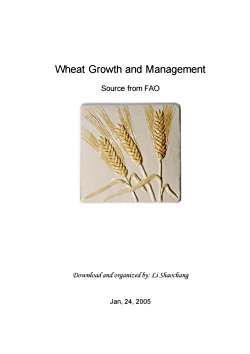
Wheat Growth and ManagementSource from FAODownload and organized by: Li ShaochangJan,24, 2005
Wheat Growth and Management Source from FAO Download and organized by: Li Shaochang Jan, 24, 2005
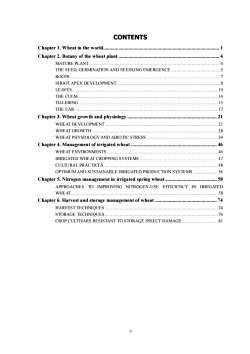
CONTENTSChapter1.Wheatintheworld.Chapter 2.Botany of the wheat plant..MATUREPLANTTHESEED,GERMINATIONANDSEEDLINGEMERGENCROOTS8SHOOTAPEXDEVELOPMENTLEAVES.10THECULM14TILLERING15THE EAR.1721Chapter 3. Wheat growth and physiologyWHEATDEVELOPMENT2128WHEATGROWTHWHEATPHYSIOLOGYANDABIOTICSTRESS.3446Chapter 4. Management of irrigated wheat..46WHEATENVIRONMENTS47IRRIGATEDWHEATCROPPINGSYSTEMS.48CULTURALPRACTICES..56OPTIMUMANDSUSTAINABLEIRRIGATEDPRODUCTIONSYSTEMS..58Chapter5.Nitrogenmanagementin irrigated springwheat..APPROACHESTO IMPROVING NITROGEN-USEEFFICIENCY INIRRIGATED58WHEAT...74Chapter6.Harvestand storage managementofwheat.74HARVESTTECHNIQUES..STORAGETECHNIOUES76CROPCULTIVARSRESISTANTTOSTORAGEINSECTDAMAGE.8111
ii CONTENTS Chapter 1. Wheat in the world. 1 Chapter 2. Botany of the wheat plant . 4 MATURE PLANT .4 THE SEED, GERMINATION AND SEEDLING EMERGENCE.5 ROOTS .7 SHOOT APEX DEVELOPMENT .8 LEAVES.10 THE CULM.14 TILLERING .15 THE EAR.17 Chapter 3. Wheat growth and physiology . 21 WHEAT DEVELOPMENT.21 WHEAT GROWTH .28 WHEAT PHYSIOLOGY AND ABIOTIC STRESS.34 Chapter 4. Management of irrigated wheat . 46 WHEAT ENVIRONMENTS .46 IRRIGATED WHEAT CROPPING SYSTEMS .47 CULTURAL PRACTICES.48 OPTIMUM AND SUSTAINABLE IRRIGATED PRODUCTION SYSTEMS .56 Chapter 5. Nitrogen management in irrigated spring wheat. 58 APPROACHES TO IMPROVING NITROGEN-USE EFFICIENCY IN IRRIGATED WHEAT .58 Chapter 6. Harvest and storage management of wheat . 74 HARVEST TECHNIQUES.74 STORAGE TECHNIQUES.76 CROP CULTIVARS RESISTANT TO STORAGE INSECT DAMAGE.81
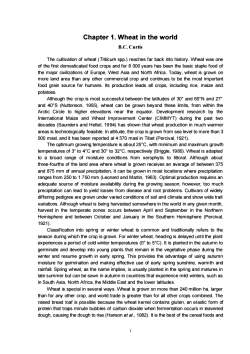
Chapter1.WheatintheworldB.C.CurtisThe cultivation of wheat (Triticum spp.) reaches far back into history. Wheat was oneof the first domesticated food crops and for 8 o00 years has been the basic staple food ofthe major civilizations of Europe, West Asia and North Africa. Today,wheat is grown onmoreland areathananyothercommercial crop andcontinuesto bethemostimportantfood grain source for humans. Its production leads all crops, including rice, maize andpotatoes.Although the crop is most successful between the latitudes of 30° and 60°N and 27°and 40°s (Nuttonson, 1955), wheat can be grown beyond these limits, from within theArctic Circle to higher elevations near the equator. Development research by theInternational Maize and Wheat Improvement Center (CIMMYT) during the past twodecades(SaundersandHettel.1994)hasshownthatwheatproductioninmuchwarmerareasistechnologicallyfeasible.Inaltitude,thecropisgrownfromsealeveltomorethan3000masl,and ithasbeen reported at4570masl inTibet (Percival, 1921).Theoptimumgrowing temperature is about 25°C, with minimumand maximum growthtemperatures of 3°to 4°C and 30°to32C,respectively (Briggle, 1980).Wheat is adaptedto a broad range of moisture conditions from xerophytic to littoral. Although aboutthree-fourths of the land area where wheat is grown receives an average of between 375and 875 mm of annual precipitation, it can be grown in most locations where precipitationranges from 250 to 1750 mm (Leonard and Martin, 1963).Optimal production requires anadequate source of moisture availability during the growing season; however, too muchprecipitation can lead to yield losses from disease and root problems. Cultivars of widelydiffering pedigreearegrown undervaried conditions of soil and climateand show widetraitvariations. Although wheat is being harvested somewhere in the world in any given month,harvestinthetemperate zones occursbetweenApril andSeptemberintheNorthernHemisphere and between October and January in the Southern Hemisphere (Percival,1921)Classification into spring or winter wheat is common and traditionally refers to theseasonduringwhichthe cropisgrown.Forwinterwheat, heading isdelayeduntiltheplantexperiencesaperiodofcoldwintertemperatures(0°to5C).Itisplantedintheautumntogerminateanddevelopintoyoungplantsthatremaininthevegetativephaseduringthewinterandresumegrowthinearlyspring.Thisprovidestheadvantageof usingautumnmoisture for germination and making effective use of early spring sunshine, warmth andrainfall.Spring wheat, asthename implies,is usuallyplanted inthespringandmatures inlatesummerbut can besown in autumn in countriesthatexperiencemild winters,such asinSouthAsia,NorthAfrica,theMiddleEastandthelowerlatitudes.Wheat is special in several ways. Wheat is grown on more than 240 million ha, largerthan for any other crop, and world trade is greater than for all other crops combined. Theraised bread loaf is possible because the wheat kernel contains gluten, an elastic form ofprotein that traps minute bubbles of carbon dioxide when fermentation occurs in leaveneddough, causing the dough to rise (Hanson et al., 1982). It is the best of the cereal foods and
1 Chapter 1. Wheat in the world B.C. Curtis The cultivation of wheat (Triticum spp.) reaches far back into history. Wheat was one of the first domesticated food crops and for 8 000 years has been the basic staple food of the major civilizations of Europe, West Asia and North Africa. Today, wheat is grown on more land area than any other commercial crop and continues to be the most important food grain source for humans. Its production leads all crops, including rice, maize and potatoes. Although the crop is most successful between the latitudes of 30° and 60°N and 27° and 40°S (Nuttonson, 1955), wheat can be grown beyond these limits, from within the Arctic Circle to higher elevations near the equator. Development research by the International Maize and Wheat Improvement Center (CIMMYT) during the past two decades (Saunders and Hettel, 1994) has shown that wheat production in much warmer areas is technologically feasible. In altitude, the crop is grown from sea level to more than 3 000 masl, and it has been reported at 4 570 masl in Tibet (Percival, 1921). The optimum growing temperature is about 25°C, with minimum and maximum growth temperatures of 3° to 4°C and 30° to 32°C, respectively (Briggle, 1980). Wheat is adapted to a broad range of moisture conditions from xerophytic to littoral. Although about three-fourths of the land area where wheat is grown receives an average of between 375 and 875 mm of annual precipitation, it can be grown in most locations where precipitation ranges from 250 to 1 750 mm (Leonard and Martin, 1963). Optimal production requires an adequate source of moisture availability during the growing season; however, too much precipitation can lead to yield losses from disease and root problems. Cultivars of widely differing pedigree are grown under varied conditions of soil and climate and show wide trait variations. Although wheat is being harvested somewhere in the world in any given month, harvest in the temperate zones occurs between April and September in the Northern Hemisphere and between October and January in the Southern Hemisphere (Percival, 1921). Classification into spring or winter wheat is common and traditionally refers to the season during which the crop is grown. For winter wheat, heading is delayed until the plant experiences a period of cold winter temperatures (0° to 5°C). It is planted in the autumn to germinate and develop into young plants that remain in the vegetative phase during the winter and resume growth in early spring. This provides the advantage of using autumn moisture for germination and making effective use of early spring sunshine, warmth and rainfall. Spring wheat, as the name implies, is usually planted in the spring and matures in late summer but can be sown in autumn in countries that experience mild winters, such as in South Asia, North Africa, the Middle East and the lower latitudes. Wheat is special in several ways. Wheat is grown on more than 240 million ha, larger than for any other crop, and world trade is greater than for all other crops combined. The raised bread loaf is possible because the wheat kernel contains gluten, an elastic form of protein that traps minute bubbles of carbon dioxide when fermentation occurs in leavened dough, causing the dough to rise (Hanson et al., 1982). It is the best of the cereal foods and
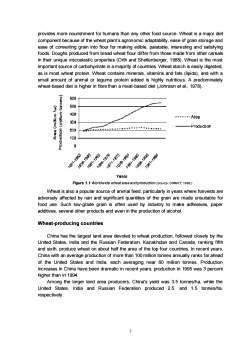
providesmorenourishmentforhumansthananyotherfood source.Wheat isamajordietcomponent because of the wheat plant's agronomic adaptability,ease of grain storage andease of converting grain into flour for making edible, palatable, interesting and satisfyingfoods.Doughsproducedfrombreadwheatflourdifferfromthosemadefromothercerealsin their unique viscoelastic properties (Orth and Shellenberger, 1988).Wheat is the mostimportantsourceofcarbohydrateinamajorityofcountries.Wheatstarchiseasilydigestedasismostwheatprotein.Wheatcontainsminerals,vitaminsandfats(lipids),andwithasmall amount of animal or legume protein added is highly nutritious.A predominatelywheat-baseddiet ishigherinfibrethanameat-baseddiet(Johnsonetal.,1978)(sauro ro uonenod600500(ey uogiu) ealy400.Area300Production2001000电名-YearsFigure1.1Worldwidewheatareaandproduction(Source:CIMMYT,1996.)Wheat is also a popular source of animal feed, particularly in years where harvests areadversely affected by rain and significant quantities of the grain are made unsuitable forfood use. Such low-grade grain is often used by industry to make adhesives, paperadditives,severalother productsand even intheproductionof alcohol.Wheat-producingcountriesChina has the largest land area devoted to wheat production, followed closely by theUnited States,IndiaandtheRussianFederation.KazakhstanandCanada,rankingfifthand sixth, produce wheat on about half the area of the top four countries. In recent years,Chinawith an averageproduction ofmore than100million tonnes annually ranks faraheadof the United States andIndia,each averagingnear 6o million tonnes.Productionincreases inChinahavebeendramaticinrecentyears;productionin1995was3percenthigher than in1994.Among the larger land area producers, China's yield was 3.5 tonnes/ha, while theUnited States, India and Russian Federation produced 2.5, and 1.5 tonnes/ha,respectively
2 provides more nourishment for humans than any other food source. Wheat is a major diet component because of the wheat plant’s agronomic adaptability, ease of grain storage and ease of converting grain into flour for making edible, palatable, interesting and satisfying foods. Doughs produced from bread wheat flour differ from those made from other cereals in their unique viscoelastic properties (Orth and Shellenberger, 1988). Wheat is the most important source of carbohydrate in a majority of countries. Wheat starch is easily digested, as is most wheat protein. Wheat contains minerals, vitamins and fats (lipids), and with a small amount of animal or legume protein added is highly nutritious. A predominately wheat-based diet is higher in fibre than a meat-based diet (Johnson et al., 1978). Wheat is also a popular source of animal feed, particularly in years where harvests are adversely affected by rain and significant quantities of the grain are made unsuitable for food use. Such low-grade grain is often used by industry to make adhesives, paper additives, several other products and even in the production of alcohol. Wheat-producing countries China has the largest land area devoted to wheat production, followed closely by the United States, India and the Russian Federation. Kazakhstan and Canada, ranking fifth and sixth, produce wheat on about half the area of the top four countries. In recent years, China with an average production of more than 100 million tonnes annually ranks far ahead of the United States and India, each averaging near 60 million tonnes. Production increases in China have been dramatic in recent years; production in 1995 was 3 percent higher than in 1994. Among the larger land area producers, China's yield was 3.5 tonnes/ha, while the United States, India and Russian Federation produced 2.5, and 1.5 tonnes/ha, respectively. Figure 1.1 Worldwide wheat area and production (Source: CIMMYT, 1996.)
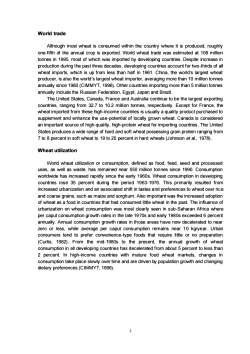
World tradeAlthough most wheat is consumed within the country where it is produced, roughlyone-fifthof the annual cropis exported.Worldwheattradewasestimatedat 108 milliontonnesin1995,mostofwhichwasimportedbydevelopingcountries.Despiteincreaseinproductionduringthepastthreedecades,developingcountriesaccountfortwo-thirdsofallwheat imports, which is up from less than half in 1961. China, the world's largest wheatproducer,isalsotheworld'slargestwheat importer,averagingmorethan10milliontonnesannually since 1980 (CIMMYT,1996).Other countries importing more than 5million tonnesannuallyincludetheRussianFederation,Egypt,JapanandBrazil.The United States,Canada,Franceand Australia continue tobe the largest exportingcountries, ranging from 32.7 to 10.2 million tonnes, respectively.Except for France, thewheatimportedfromthesehigh-incomecountries is usuallyaqualityproductpurchasedtosupplement and enhancethe use-potential of locally grown wheat. Canada is consideredan important source of high-quality,high-protein wheat for importing countries.The UnitedStates produces a widerange of hard andsoft wheat possessinggrain protein ranging from7to8percent insoftwheatto19to20percent inhardwheats(Johnsonetal.,1978)WheatutilizationWorld wheat utilization or consumption, defined as food, feed, seed and processeduses, as well as waste, has remained near 550 million tonnes since 1990.Consumptionworldwidehas increased rapidly since the early1960s.Wheat consumption indevelopingcountries rose 35 percent during the period 1963-1976. This primarily resulted fromincreasedurbanizationandanassociatedshiftintastesandpreferencestowheatoverriceand coarse grains, such as maize and sorghum. Also important was the increased adoptionof wheat as a food in countries that had consumed little wheat in the past. The influence ofurbanizationonwheatconsumptionwas mostclearlyseen insub-SaharanAfricawherepercaput consumptiongrowthrates in thelate1970sandearly1980sexceeded6percentannually.Annualconsumptiongrowthratesinthoseareashavenowdeceleratedtonearzero orless,while averageper caputconsumption remains near1okg/year.Urbanconsumers tend to prefer convenience-type foods that require little or no preparation(Curtis, 1982). From the mid-1980s to the present, the annual growth of wheatconsumption in all developing countries has decelerated from about 5 percent toless than2 percent. In high-income countries with mature food wheat markets, changes inconsumption take place slowly over time and aredriven by population growth and changingdietary preferences (CIMMYT,1996)
3 World trade Although most wheat is consumed within the country where it is produced, roughly one-fifth of the annual crop is exported. World wheat trade was estimated at 108 million tonnes in 1995, most of which was imported by developing countries. Despite increase in production during the past three decades, developing countries account for two-thirds of all wheat imports, which is up from less than half in 1961. China, the world’s largest wheat producer, is also the world’s largest wheat importer, averaging more than 10 million tonnes annually since 1980 (CIMMYT, 1996). Other countries importing more than 5 million tonnes annually include the Russian Federation, Egypt, Japan and Brazil. The United States, Canada, France and Australia continue to be the largest exporting countries, ranging from 32.7 to 10.2 million tonnes, respectively. Except for France, the wheat imported from these high-income countries is usually a quality product purchased to supplement and enhance the use-potential of locally grown wheat. Canada is considered an important source of high-quality, high-protein wheat for importing countries. The United States produces a wide range of hard and soft wheat possessing grain protein ranging from 7 to 8 percent in soft wheat to 19 to 20 percent in hard wheats (Johnson et al., 1978). Wheat utilization World wheat utilization or consumption, defined as food, feed, seed and processed uses, as well as waste, has remained near 550 million tonnes since 1990. Consumption worldwide has increased rapidly since the early 1960s. Wheat consumption in developing countries rose 35 percent during the period 1963-1976. This primarily resulted from increased urbanization and an associated shift in tastes and preferences to wheat over rice and coarse grains, such as maize and sorghum. Also important was the increased adoption of wheat as a food in countries that had consumed little wheat in the past. The influence of urbanization on wheat consumption was most clearly seen in sub-Saharan Africa where per caput consumption growth rates in the late 1970s and early 1980s exceeded 6 percent annually. Annual consumption growth rates in those areas have now decelerated to near zero or less, while average per caput consumption remains near 10 kg/year. Urban consumers tend to prefer convenience-type foods that require little or no preparation (Curtis, 1982). From the mid-1980s to the present, the annual growth of wheat consumption in all developing countries has decelerated from about 5 percent to less than 2 percent. In high-income countries with mature food wheat markets, changes in consumption take place slowly over time and are driven by population growth and changing dietary preferences (CIMMYT, 1996)
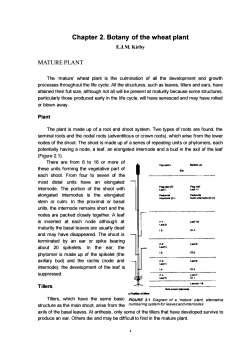
Chapter2.BotanyofthewheatplantE.J.M. KirbyMATUREPLANTThe ‘mature' wheat plant is the culmination of all the development and growthprocessesthroughoutthelifecycle.Allthestructures,suchasleaves,tillersandears,haveattained their full size, although not all will be present at maturity because some structures,particularlythoseproduced earlyinthe lifecycle,will have senescedandmayhaverottedorblown away.PlantTheplantismadeupofarootandshootsystem.Twotypesofrootsarefound,theseminalrootsandthenodalroots(adventitiousorcrownroots).whicharisefromthelowernodesoftheshoot.Theshoot ismadeupofaseriesofrepeatingunitsorphytomers,eachpotentially having a node,a leaf, an elongated internode and a bud in the axil of the leaf(Figure 2.1).There are from 6 to 16 or more ofTop downBofUthese units forming the vegetative part ofeach shoot. From four to seven of themost distal units have an elongatedEarCa aininternode. The portion of the shoot withelongated internodes is the elongatedPedunclePeduncloCumimermode(Cnstnternode()1stemorculm.Intheproximalorbasalunits, the internode remains short and thenodesarepackedcloselytogether.Aleafis inserted at each node although atta2Leaf 10maturitythebasal leaves are usuallydeadCI412and may have disappeared. The shoot isterminated by an ear or spike bearingtar?Loaieabout 20spikelets.In theear,the1chaphytomer is made up of the spikelet (theaxillarybud)and the rachis (node andLoMeEar.internode):thedevelopmentoftheleafisC12suppressed.Esr.Con?TillersnrnodePuPosidoncftmenTillers, which have the same basic FIGURE 2.1 Diagram of a 'mature'plant, alternativenumberingsystemforleavesandinternodesstructureasthemainshoot,arisefromtheaxilsofthebasal leaves.Atanthesis,onlysomeofthetillersthathavedevelopedsurvivetoproduceanear.Othersdieandmaybedifficulttofind inthematureplant.4
4 Chapter 2. Botany of the wheat plant E.J.M. Kirby MATURE PLANT The ‘mature’ wheat plant is the culmination of all the development and growth processes throughout the life cycle. All the structures, such as leaves, tillers and ears, have attained their full size, although not all will be present at maturity because some structures, particularly those produced early in the life cycle, will have senesced and may have rotted or blown away. Plant The plant is made up of a root and shoot system. Two types of roots are found, the seminal roots and the nodal roots (adventitious or crown roots), which arise from the lower nodes of the shoot. The shoot is made up of a series of repeating units or phytomers, each potentially having a node, a leaf, an elongated internode and a bud in the axil of the leaf (Figure 2.1). There are from 6 to 16 or more of these units forming the vegetative part of each shoot. From four to seven of the most distal units have an elongated internode. The portion of the shoot with elongated internodes is the elongated stem or culm. In the proximal or basal units, the internode remains short and the nodes are packed closely together. A leaf is inserted at each node although at maturity the basal leaves are usually dead and may have disappeared. The shoot is terminated by an ear or spike bearing about 20 spikelets. In the ear, the phytomer is made up of the spikelet (the axillary bud) and the rachis (node and internode); the development of the leaf is suppressed. Tillers Tillers, which have the same basic structure as the main shoot, arise from the axils of the basal leaves. At anthesis, only some of the tillers that have developed survive to produce an ear. Others die and may be difficult to find in the mature plant. FIGURE 2.1 Diagram of a 'mature' plant, alternative numbering system for leaves and internodes
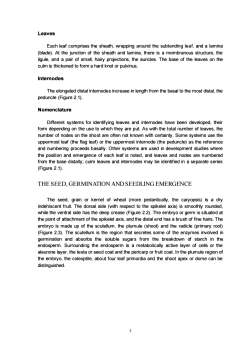
LeavesEachleaf comprisesthe sheath, wrapping around the subtending leaf,and a lamina(blade).Atthe junctionof thesheathandlamina,there isamembranous structure,theligule, and a pair of small, hairy projections, the auricles. The base of the leaves on theculmisthickenedtoformahardknotorpulvinus.InternodesThe elongated distal internodes increase in length from the basal to the most distal, thepeduncle (Figure 2.1)NomenclatureDifferent systems for identifying leaves and internodes have been developed, theirfom depending on the use to which they are put. As with the total number of leaves, thenumberofnodesontheshootareoftennotknownwithcertainty.Somesystemsusetheuppermost leaf (theflagleaf)orthe uppermost internode (thepeduncle)asthereferenceandnumberingproceedsbasally.Othersystemsareusedindevelopmentstudieswherethe position and emergence of each leaf is noted, and leaves and nodes are numberedfromthebasedistally;culm leaves and internodesmaybeidentified in aseparate series(Figure 2.1).THESEED.GERMINATIONANDSEEDLINGEMERGENCEThe seed, grain or kernel of wheat (more pedantically, the caryopsis) is a dryindehiscent fruit. The dorsal side (with respect to the spikelet axis) is smoothly rounded,while the ventral side has the deep crease (Figure 2.2). The embryo or germ is situated atthepoint of attachment of the spikelet axis,andthe distal end has a brushof finehairs.Theembryoismadeupofthescutellum,theplumule(shoot)andtheradicle(primaryroot)(Figure2.3).Thescutellumistheregionthatsecretessomeoftheenzymesinvolvedingermination and absorbs the soluble sugars from the breakdown of starch in theendosperm.Surroundingtheendospermisametabolicallyactivelayerof cellsorthealeuronelayer,thetestaorseedcoatandthepericarporfruit coat.Intheplumuleregionoftheembryo,thecoleoptile,about fourleaf primordiaandtheshootapexordomecanbedistinguished
5 Leaves Each leaf comprises the sheath, wrapping around the subtending leaf, and a lamina (blade). At the junction of the sheath and lamina, there is a membranous structure, the ligule, and a pair of small, hairy projections, the auricles. The base of the leaves on the culm is thickened to form a hard knot or pulvinus. Internodes The elongated distal internodes increase in length from the basal to the most distal, the peduncle (Figure 2.1). Nomenclature Different systems for identifying leaves and internodes have been developed, their form depending on the use to which they are put. As with the total number of leaves, the number of nodes on the shoot are often not known with certainty. Some systems use the uppermost leaf (the flag leaf) or the uppermost internode (the peduncle) as the reference and numbering proceeds basally. Other systems are used in development studies where the position and emergence of each leaf is noted, and leaves and nodes are numbered from the base distally; culm leaves and internodes may be identified in a separate series (Figure 2.1). THE SEED, GERMINATION AND SEEDLING EMERGENCE The seed, grain or kernel of wheat (more pedantically, the caryopsis) is a dry indehiscent fruit. The dorsal side (with respect to the spikelet axis) is smoothly rounded, while the ventral side has the deep crease (Figure 2.2). The embryo or germ is situated at the point of attachment of the spikelet axis, and the distal end has a brush of fine hairs. The embryo is made up of the scutellum, the plumule (shoot) and the radicle (primary root) (Figure 2.3). The scutellum is the region that secretes some of the enzymes involved in germination and absorbs the soluble sugars from the breakdown of starch in the endosperm. Surrounding the endosperm is a metabolically active layer of cells or the aleurone layer, the testa or seed coat and the pericarp or fruit coat. In the plumule region of the embryo, the coleoptile, about four leaf primordia and the shoot apex or dome can be distinguished

Thecoleoptileiswell developed inthe embryo,formingathimble-shaped structurecovering the leaf primordia and the shoot meristem. At germination, it bursts through thepericarp and testa and grows through the soil mainly by the action of an intercalarymeristem,whichfoms about 10mmbehind thetipandstaysatthispositionthroughout thegrowthof the coleoptile.Vascular tissue and stomata differentiate during thegrowth of thecoleoptile.grushThe fully elongated coleoptile is atubularstructuretypicallyabout50mmlong and 2 mm in diameter.It is whitein colour exceptfortwo lateral strandsof chlorophyllous tissueassociatedwiththevascular strands.Theendofthecoleoptile isbullet-shaped andGerclosed exceptfor a small pore 0.25FIGURE2.2Wheatgrain,showingdifferentaspectsandcrossmmlonga shortdistancebehindthesectiontoillustratethedepthofthecreasetip and on the side opposite theSatelumscutellum.ColeoptleTwo vascular bundles are foundLeeftlaterally placed with reference to theaedf2scutellum-coleoptileplane.OneortwoDomeLad3lines of stomata extending from thebaseto thetip arefound intheouterepidermisassociatedwitheachvascularbundle.Theytendtobemorenumeroustowardsthetip.Stomataalso occur in the inner epidermisthough they are less frequent.Theguard cells of the stomata do not haveFIGURE2.3Longitudinal sectionoftheembryofromathe characteristic dumbbell shape,maturegrain,withtheapexand leaves oftheshootpresentsuchasthosefound intheleaf,butareandatillerbudvisiblekidney-shaped, similar to dicotyledonguard cells.The other cells of the outerepidermis have thickened walls thatare finely wrinkled,the crests of thewrinklesoccurringat1to2mmintervals.The inner epidermis has anunthickened wall, which is not wrinkled.The parenchyma tissue between theouterandinnerepidermisiscomposedof large regular cells, which containFIGURE2.4Adeeplysownseeding(left)withcoleoptileplastids.removed,showingthedevelopmentofthesub-crowinternodeWhenaseedissowninasuitableandthepositionofthecrown,comparedtoaseedlingsownatoptimumdepth (right);notethedifference in tilleringmoist and aerated soil it germinates.6
6 The coleoptile is well developed in the embryo, forming a thimble-shaped structure covering the leaf primordia and the shoot meristem. At germination, it bursts through the pericarp and testa and grows through the soil mainly by the action of an intercalary meristem, which forms about 10 mm behind the tip and stays at this position throughout the growth of the coleoptile. Vascular tissue and stomata differentiate during the growth of the coleoptile. The fully elongated coleoptile is a tubular structure typically about 50 mm long and 2 mm in diameter. It is white in colour except for two lateral strands of chlorophyllous tissue associated with the vascular strands. The end of the coleoptile is bullet-shaped and closed except for a small pore 0.25 mm long a short distance behind the tip and on the side opposite the scutellum. Two vascular bundles are found laterally placed with reference to the scutellum-coleoptile plane. One or two lines of stomata extending from the base to the tip are found in the outer epidermis associated with each vascular bundle. They tend to be more numerous towards the tip. Stomata also occur in the inner epidermis though they are less frequent. The guard cells of the stomata do not have the characteristic dumbbell shape, such as those found in the leaf, but are kidney-shaped, similar to dicotyledon guard cells. The other cells of the outer epidermis have thickened walls that are finely wrinkled, the crests of the wrinkles occurring at 1 to 2 mm intervals. The inner epidermis has an unthickened wall, which is not wrinkled. The parenchyma tissue between the outer and inner epidermis is composed of large regular cells, which contain plastids. When a seed is sown in a suitable moist and aerated soil it germinates. FIGURE 2.4 A deeply sown seeding (left) with coleoptile removed, showing the development of the sub-crow internode and the position of the crown, compared to a seedling sown at optimum depth (right); note the difference in tillering FIGURE 2.2 Wheat grain, showing different aspects and cross section to illustrate the depth of the crease FIGURE 2.3 Longitudinal section of the embryo from a mature grain, with the apex and leaves of the shoot present and a tiller bud visible
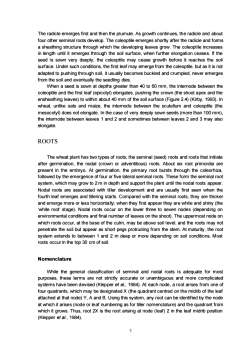
Theradicleemergesfirstandthentheplumule.Asgrowthcontinues,theradicleandaboutfourotherseminal rootsdevelop.Thecoleoptileemergesshortlyaftertheradicleandfomsa sheathing structure through which the developing leaves grow.The coleoptile increasesin length until it emerges through the soil surface, when further elongation ceases. If theseed is sown very deeply, the coleoptile may cease growth before it reaches the soilsurface.Undersuchconditions,thefirstleafmayemergefromthecoleoptile,butasitisnotadaptedtopushingthroughsoil,itusuallybecomesbuckledandcrumpled,neveremergesfrom the soil and eventually the seedling dies.Whena seed issownatdepths greaterthan40to60mm,the internodebetweenthecoleoptileandthefirstleaf(epicotyl)elongates,pushingthecrown(theshootapexandtheensheathing leaves) to within about 40 mm of the soil surface (Figure 2.4) (Kirby, 1993). Inwheat,unlike oats and maize,the internode between the scutellum and coleoptile (themesocotyl)doesnotelongate.Inthecaseofverydeeplysownseeds(morethan1oomm)the internode between leaves 1 and 2 and sometimes between leaves 2 and 3 may alsoelongate.ROOTSThewheatplanthastwotypesofroots,theseminal(seed)rootsandrootsthatinitiateafter germination,the nodal(crown or adventitious)roots.About six root primordia arepresent in the embryo. At germination, the primary root bursts through the coleorhizafollowedbytheemergenceoffourorfivelateralseminal roots.Theseformtheseminalrootsystem, which may grow to 2 m in depth and support the plant until the nodal roots appear.Nodal roots are associated with tiller development and are usually first seen when thefourthleafemergesandtilleringstarts.Comparedwiththeseminal roots,theyarethickerandemergemoreorlesshorizontally:whentheyfirstappeartheyarewhiteandshiny(thewhiteroot'stage).Nodalrootsoccuronthelowerthreetosevennodes(dependingonenvironmentalconditionsandfinal numberof leavesontheshoot).Theuppermostnodeonwhichrootsoccur,atthebaseof theculm.maybeabovesoil level,andtherootsmaynotpenetrate the soil but appear as short pegs protruding from the stem. At maturity, the rootsystemextendstobetween1and2mdeepormoredependingonsoil conditions.Mostrootsoccurinthetop30cmofsoil.NomenclatureWhile the general classification of seminal and nodal roots is adequate for mostpurposes,theseterms are not strictly accurate or unambiguous and more complicatedsystemshavebeendevised(Klepperetal.,1984).Ateachnode,arootarisesfromoneoffour quadrants, which may be designated X (the quadrant centred on the midrib of the leafattached at that node) Y,A and B. Using this system, any root can be identified by the nodeatwhichitarises(nodeorleafnumberingasfortillernomenclature)andthequadrantfromwhich it grows. Thus, root 2X is the root arising at node (leaf) 2 in the leaf midrib position(Klepper et al., 1984).7
7 The radicle emerges first and then the plumule. As growth continues, the radicle and about four other seminal roots develop. The coleoptile emerges shortly after the radicle and forms a sheathing structure through which the developing leaves grow. The coleoptile increases in length until it emerges through the soil surface, when further elongation ceases. If the seed is sown very deeply, the coleoptile may cease growth before it reaches the soil surface. Under such conditions, the first leaf may emerge from the coleoptile, but as it is not adapted to pushing through soil, it usually becomes buckled and crumpled, never emerges from the soil and eventually the seedling dies. When a seed is sown at depths greater than 40 to 60 mm, the internode between the coleoptile and the first leaf (epicotyl) elongates, pushing the crown (the shoot apex and the ensheathing leaves) to within about 40 mm of the soil surface (Figure 2.4) (Kirby, 1993). In wheat, unlike oats and maize, the internode between the scutellum and coleoptile (the mesocotyl) does not elongate. In the case of very deeply sown seeds (more than 100 mm), the internode between leaves 1 and 2 and sometimes between leaves 2 and 3 may also elongate. ROOTS The wheat plant has two types of roots, the seminal (seed) roots and roots that initiate after germination, the nodal (crown or adventitious) roots. About six root primordia are present in the embryo. At germination, the primary root bursts through the coleorhiza, followed by the emergence of four or five lateral seminal roots. These form the seminal root system, which may grow to 2 m in depth and support the plant until the nodal roots appear. Nodal roots are associated with tiller development and are usually first seen when the fourth leaf emerges and tillering starts. Compared with the seminal roots, they are thicker and emerge more or less horizontally; when they first appear they are white and shiny (the ‘white root’ stage). Nodal roots occur on the lower three to seven nodes (depending on environmental conditions and final number of leaves on the shoot). The uppermost node on which roots occur, at the base of the culm, may be above soil level, and the roots may not penetrate the soil but appear as short pegs protruding from the stem. At maturity, the root system extends to between 1 and 2 m deep or more depending on soil conditions. Most roots occur in the top 30 cm of soil. Nomenclature While the general classification of seminal and nodal roots is adequate for most purposes, these terms are not strictly accurate or unambiguous and more complicated systems have been devised (Klepper et al., 1984). At each node, a root arises from one of four quadrants, which may be designated X (the quadrant centred on the midrib of the leaf attached at that node) Y, A and B. Using this system, any root can be identified by the node at which it arises (node or leaf numbering as for tiller nomenclature) and the quadrant from which it grows. Thus, root 2X is the root arising at node (leaf) 2 in the leaf midrib position (Klepper et al., 1984)
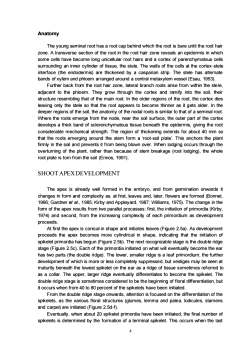
AnatomyTheyoungseminal roothasarootcapbehindwhichtheroot isbareuntiltheroothairzone.Atransverse section of the root in the root hair zone reveals an epidermis in whichsome cells have become long unicellular root hairs and a cortex of parenchymatous cellssurrounding an inner cylinder of tissue,the stele.The walls of the cells at the cortex-steleinterface (the endodermis) are thickened by a casparian strip. The stele has alternatebands ofxylemand phloem arrangedaround a central metaxylemvessel (Esau,1953)Furtherbackfromtheroothairzone,lateralbranchrootsarisefromwithinthesteleadjacent to the phloem.They grow throughthe cortexand ramifyintothe soil,theirstructure resemblingthat of the main root.In the older regions of theroot,the cortex diesleaving only the stele so that the root appears to become thinner as it gets older. In thedeeper regions of the soil, the anatomy of the nodal roots is similar to that of a seminal root.Wheretheroots emergefrom the node,nearthe soil surface,theouter part of the cortexdevelops a thick band of sclerenchymatous tissue beneath the epidermis, giving the rootconsiderablemechanicalstrength.Theregionofthickeningextendsforabout4ommsothat the roots emerging around the stem form a 'root-soil plate'. This anchors the plantfirmlyinthesoil andpreventsitfrombeingblownover.Whenlodgingoccursthroughtheoverturning oftheplant,ratherthan because of stem breakage(root lodging),the wholeroot plate is torn from the soil (Ennos, 1991).SHOOTAPEXDEVELOPMENTThe apex is already well formed in the embryo, and from gemination onwards itchanges in form and complexity as, at first, leaves and, later, flowers are formed (Bonnet1966; Gardner et al., 1985; Kirby and Appleyard, 1987; Williams, 1975). The change in thefomoftheapexresultsfromtwoparallel processes:first,theinitiationofprimordia(Kirby,1974)andsecond.fromtheincreasingcomplexityofeachprimordiumasdevelopmentproceeds.At first the apex is conical in shape and initiates leaves (Figure 2.5a). As developmentproceeds the apex becomes more cylindrical in shape,indicating thatthe initiation ofspikelet primordia has begun (Figure 2.5b). The next recognizable stage is the double ridgestage (Figure 2.5c).Each of the primordia initiated on what will eventually become the earhas two parts (the double ridge). The lower, smaller ridge is a leaf primordium, the furtherdevelopmentofwhichismoreorlesscompletelysuppressed,butvestigesmaybeseenatmaturitybeneaththe lowest spikelet onthe earas a ridge of tissue sometimes referredtoasacollar.Theupper,largerridgeeventuallydifferentiatestobecomethespikelet.Thedoubleridge stage is sometimes considered to be the beginning of floral differentiation, butitoccurswhenfrom40to80percentofthespikeletshavebeeninitiated.Fromthedoubleridgestageonwards,attentionisfocusedonthedifferentiationofthespikelets, as the various floral structures (glumes, lemma and palea, lodicules, stamensand carpel)are initiated (Figure 2.5d-f).Eventually,whenabout20spikeletprimordiahavebeeninitiated,thefinal numberofspikelets is determined by the formation of a terminal spikelet.This occurs when the lastX
8 Anatomy The young seminal root has a root cap behind which the root is bare until the root hair zone. A transverse section of the root in the root hair zone reveals an epidermis in which some cells have become long unicellular root hairs and a cortex of parenchymatous cells surrounding an inner cylinder of tissue, the stele. The walls of the cells at the cortex-stele interface (the endodermis) are thickened by a casparian strip. The stele has alternate bands of xylem and phloem arranged around a central metaxylem vessel (Esau, 1953). Further back from the root hair zone, lateral branch roots arise from within the stele, adjacent to the phloem. They grow through the cortex and ramify into the soil, their structure resembling that of the main root. In the older regions of the root, the cortex dies leaving only the stele so that the root appears to become thinner as it gets older. In the deeper regions of the soil, the anatomy of the nodal roots is similar to that of a seminal root. Where the roots emerge from the node, near the soil surface, the outer part of the cortex develops a thick band of sclerenchymatous tissue beneath the epidermis, giving the root considerable mechanical strength. The region of thickening extends for about 40 mm so that the roots emerging around the stem form a ‘root-soil plate’. This anchors the plant firmly in the soil and prevents it from being blown over. When lodging occurs through the overturning of the plant, rather than because of stem breakage (root lodging), the whole root plate is torn from the soil (Ennos, 1991). SHOOT APEX DEVELOPMENT The apex is already well formed in the embryo, and from germination onwards it changes in form and complexity as, at first, leaves and, later, flowers are formed (Bonnet, 1966; Gardner et al., 1985; Kirby and Appleyard, 1987; Williams, 1975). The change in the form of the apex results from two parallel processes: first, the initiation of primordia (Kirby, 1974) and second, from the increasing complexity of each primordium as development proceeds. At first the apex is conical in shape and initiates leaves (Figure 2.5a). As development proceeds the apex becomes more cylindrical in shape, indicating that the initiation of spikelet primordia has begun (Figure 2.5b). The next recognizable stage is the double ridge stage (Figure 2.5c). Each of the primordia initiated on what will eventually become the ear has two parts (the double ridge). The lower, smaller ridge is a leaf primordium, the further development of which is more or less completely suppressed, but vestiges may be seen at maturity beneath the lowest spikelet on the ear as a ridge of tissue sometimes referred to as a collar. The upper, larger ridge eventually differentiates to become the spikelet. The double ridge stage is sometimes considered to be the beginning of floral differentiation, but it occurs when from 40 to 80 percent of the spikelets have been initiated. From the double ridge stage onwards, attention is focused on the differentiation of the spikelets, as the various floral structures (glumes, lemma and palea, lodicules, stamens and carpel) are initiated (Figure 2.5d-f). Eventually, when about 20 spikelet primordia have been initiated, the final number of spikelets is determined by the formation of a terminal spikelet. This occurs when the last
按次数下载不扣除下载券;
注册用户24小时内重复下载只扣除一次;
顺序:VIP每日次数-->可用次数-->下载券;
- 《作物栽培学》课程教学资源(讲义)Cotton Growth and Development.doc
- 《作物栽培学》课程教学大纲(作物栽培学双语教学大纲).doc
- 《作物栽培学》课程教学大纲(作物研究法综合实验大纲).doc
- 《作物栽培学》课程教学大纲(农学实践基础)Principle of Basis on Agronomy Practice.doc
- 《作物栽培学》课程教学大纲(作物高产生理学综合实验大纲).doc
- 《作物栽培学》课程教学大纲(农学实践基础)Agronomy Practice.doc
- 《作物栽培学》课程教学大纲(作物栽培生理研究法)Crop Cultivation Physiology and Research Technique.doc
- 《作物栽培学》课程教学大纲(作物栽培学专题)Topic on Crop Cultivation Science.doc
- 《作物栽培学》课程实验指导(PPT讲稿)实验三 小麦幼穗分化的观察-1/2.ppt
- 《作物栽培学》课程实验指导(PPT讲稿)实验二 小麦、大麦、燕麦和黑麦的形态特征观察及亚种的识别.ppt
- 《作物栽培学》课程实验教学大纲(农学).doc
- 《作物栽培学》课程实验教学大纲(植保).doc
- 《作物栽培学》课程实验指导(PPT讲稿)实验三 小麦幼穗分化的观察-2/2.ppt
- 《作物栽培学》课程实验指导(PPT讲稿)实验四 玉米形态特征及类型识别-1/2.ppt
- 《作物栽培学》课程实验指导(PPT讲稿)实验四 玉米形态特征及类型识别-2/2.ppt
- 《作物栽培学》课程实验指导(PPT讲稿)实验六 棉花的形态观察及四个栽培棉种识别.ppt
- 《作物栽培学》课程实验指导(PPT讲稿)实验八 油菜的形态特征观察及经济性状分析.ppt
- 《作物栽培学》课程实验指导(PPT讲稿)实验五 水稻种子发芽特征观察.ppt
- 《作物栽培学》课程实验指导(PPT讲稿)实验九 甜菜形态结构观察及块根含糖量测定.ppt
- 《作物栽培学》课程实验指导(PPT讲稿)实验七 棉花测产.ppt
- 《作物栽培学》课程教学课件(PPT讲稿)第七章 油菜栽培.ppt
- 《作物栽培学》课程教学课件(讲稿)第十章 加工番茄栽培技术.pdf
- 《作物栽培学》课程教学课件(PPT讲稿)第九章 甜菜栽培.ppt
- 《作物栽培学》课程教学课件(PPT讲稿)第八章 大豆栽培.ppt
- 《作物栽培学》课程教学课件(PPT讲稿)第三章 水稻栽培.ppt
- 《作物栽培学》课程教学课件(PPT讲稿)第六章 向日葵栽培.ppt
- 《作物栽培学》课程教学课件(PPT讲稿)第五章 棉花栽培.ppt
- 《作物栽培学》课程教学课件(讲稿)第二章 小麦栽培.pdf
- 《作物栽培学》课程教学课件(讲稿)第四章 玉米栽培.pdf
- 《作物栽培学》课程教学课件(PPT讲稿)第一章 概论.ppt
- 《农业昆虫学》课程教学大纲 Agricultural Entomology.pdf
- 《农业昆虫学》课程考试大纲 Agricultural Entomology.pdf
- 《农业昆虫学》课程授课教案(石河子大学:张建萍).doc
- 《农业昆虫学》课程各章习题集(无答案).doc
- 《农业昆虫学》课程作业试题库(无答案).doc
- 《农业昆虫学》课程教学实验指导书(共十二个实验).doc
- 《农业昆虫学》课程教学资源(PPT课件)第十一章 棉花害虫(蓟马类、盲蝽蝽).pps
- 《农业昆虫学》课程教学资源(PPT课件)第十一章 棉花害虫(棉蚜 cotton aphid).pps
- 《农业昆虫学》课程教学资源(PPT课件)第十章 粮食作物害虫.pps
- 《农业昆虫学》课程教学资源(PPT课件)第十二章 储粮害虫 Stored grain(insect)pests.pps
